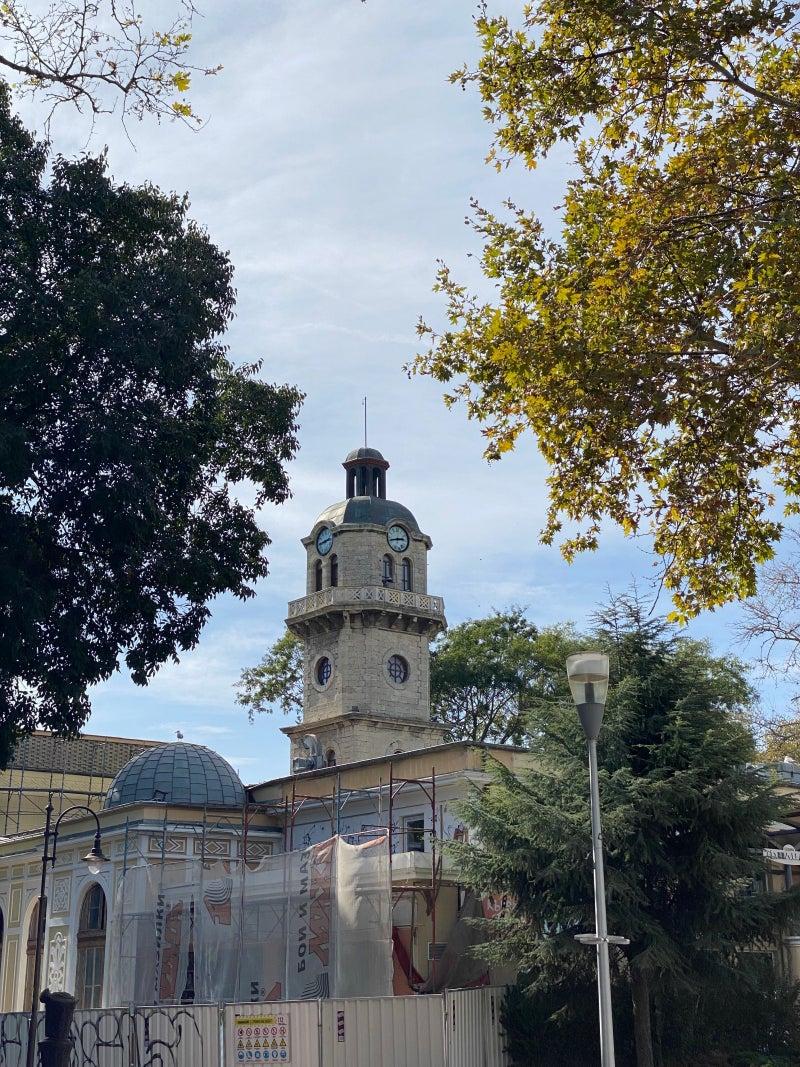iPhone 15 Pro Max vs iPhone 11 Pro Max: ready for the jump?
We may earn a commission if you make a purchase from the links on this page.

Intro
Apple's latest phones are the iPhone 15 series, which released in September, 2023 — as is tradition. The Pro models were pretty well received, with the new Action Button, titanium coat, and a new zoom camera in the Pro Max. Also, they now come with USB Type-C with super-fast USB 3 data transfer speeds!
The iPhone 15 Pro Max is, of course, the biggest, most expensive, most powerful of the bunch. Sporting the new A17 Pro chip and an exclusive new 5x zoom lens, thinner bezels, and titanium frame — it looks and feels new. Especially when compared to a pretty old iPhone 11 Pro Max.
If you happen to still be holding on to that 4-year flagship, you may be wondering if now is a good time to upgrade. It's a fair question — the old flagship has gotten iOS 17 and is now nearing its 4th anniversary, so it should still get iOS 26 this year. The new OS has landed, learn more about it in the "performance" section.
But it's not all about software — a lot has changed since the 11 series was released. iPhone Pro models now have 120 Hz screens, much improved cameras, a massive performance bump, longer battery life, a new design, MagSafe... the notch (errr, it's now an Island)! So, is all of that worth it?
iPhone 15 Pro Max vs iPhone 11 Pro Max differences:
- Full redesign — boxy and rectangular, versus the rounded corners of iPhone 11
- MagSafe compatibility — welcome to the world of magnet accessories!
- 120 Hz screen vs 60 Hz screen
- Much higher max brightness on iPhone 15
- Dynamic Island vs Notch
- Titanium frame on the 15 for a premium touch
- Mute switch is upgraded to Action Button
- A17 Pro is a significant upgrade over A13 Bionic
- 256 GB base storage vs 64 GB base storage
- Upgraded 48 MP main camera
- New 5x zoom
- Overall improved low light performance of cameras
- USB Type C with USB 3 speeds instead of Lightning (and USB 2)
- Massive battery capacity upgrade
Table of Contents:
Read more:
Design and Size
Welcome to the future past
The iPhone 12 series changed the overall design of the iPhones by adding right angles, flat frames, and a magnetic array on their back to make them compatible with MagSafe accessories (stands, charging banks, wireless chargers, magnetic wallets). The iPhone 13 series made the notch (the selfie camera cutout at the top of the screen) smaller. And the 14 series, particularly the iPhone 14 Pro and iPhone 14 Pro Max, replaced the notch with a pill-shaped cutout that is masked by animated widgets. Apple calls this the Dynamic Island and it's basically a way of enriching the multi-tasking experience with the iPhone.
Yeah, you have a bit of catching up to do.
The iPhone 15 Pro Max does, of course, inherit all of those features and adds a slight facelift — a thinner bezel around the screen and a beveled frame, so it doesn't feel quite as angular. Plus, its sides are now titanium and come with the brushed titanium finish to boot.
The signature mute switch that you have on the side of the iPhone 11 Pro Max is also gone, making room for a new "Action Button". By default, it's still a mute toggle, but it can now be programmed to launch your favorite apps or toggle phone features like the flashlight. It can even launch a Siri Shortcut of your choosing, however, once the Action Button is programmed to do one thing, it loses its mute functionality.
The iPhone 11 Pro Max has that oldschool rounded frame, which we definitely miss. If you are having a hard time parting with that, we get it. However, if you do, you will find yourself in the wonderful world of MagSafe accessories — cases, stands, and chargers that magically stick to the iPhone. So, it's a give and take.
Display Differences
The Pro Max screen size has been upgraded to 6.7 inches since the iPhone 12 Pro Max — since then, it hasn't moved. That's still 0.2 inches bigger than the iPhone 11 Pro Max' 6.5-inch screen.
The iPhone 15 Pro Max still has an OLED panel, just like the iPhone 11 Pro Max, but it has a higher refresh rate — 120 Hz ProMotion, as first seen on the iPhone 13 Pro.
But a much more capable OLED panel — Apple's iPhones can now blast out 2,000 nits of peak brightness, which is 2.5 times the iPhone 11 Pro Max's 800 nits. The latter is OK to view under direct sunlight, but obviously doesn't have the headroom of the 15 Pro Max.
Color calibration seems to be similar on both — since switching to OLED, Apple has had a slightly green-ish or teal-ish cast on whites. But color reproduction is otherwise on point and always a pleasure to view. That is, of course, before you turn on True Tone or Night Shift, both of which make the screen warmer and softer, depending on ambient lighting and time of day.
Early iPhone 15 Pro adopters had a bit of a scare with what looked like screen burn-in issues. Turns out it was all software, and it was an "image persistence" glitch, which was fixed with iOS 17.1
Also, we have an Always On Display now — the iPhone 14 Pro introduced it and the iPhone 15 Pro inherits it. Basically, even when the phone is in standby, some pixels on the screen remain lit to show you notifications or even feed you real-time info (refresh rate is dropped to 1 Hz, for battery saving reasons, of course).
Performance and Software
Nanometers of difference

All hail the Apple A17 Pro — the first 3 nm SoC on a smartphone. Quick nerd talk — the nanometers here signify the size of the transistors in the chip. Obviously, when they are smaller you have room for more transistors, which in turn gives you a more energy-efficient chip. Sure... we are literally talking about nanometers. But, when we consider that the Apple A13 Bionic inside the iPhone 11 Pro Max is built on a 7 nm process, we realize that the A17 has enough room to double its energy-efficiency over the 2019 model.
Quick non-nerd talk — it will go vroom faster and it will do it for longer.
iPhones with the A17 Pro had some overheating issues early on. These were more or less fixed with iOS 17.0.3 with minimal difference in performance — we ran the benchmarks again after it was pushed out.
We did find the Apple A17 Pro to be extremely fast and powerful, but it's also a drain on the iPhone 15 Pro Max' precious battery (more on that later). It is very definitely a performance jump leap over what the iPhone 11 Pro Max has to offer.
And, would you look at that — the iPhone 15 Pro Max comes with a USB Type-C port, thanks to the EU regulators basically forcing Apple to switch. It will now support USB 3 speeds with an *optional* USB 3 cable. Why is that a big deal? Because it's about 20 times faster than the old USB 2.0 standard, which Lightning still operates under. Anyone who has tried to copy videos from their iPhone to their Windows PC knows why this is a pain — it's basically impossible due to the slow transfer and the 4K videos being huge.
The A17 Pro also has hardware-accelerated ray tracing and Apple touted its gaming prowess. It even dragged some big names into the presentation, like Ubisoft's The Division Resurgence, Assassin's Creed: Mirage, and Capcom's Resident Evil Village.
No doubt, if you were to switch from an iPhone 11 Pro Max to an iPhone 15 Pro Max today, you'd notice a massive leap in performance. From the touch response and fluid animations to fast app launches.
iOS 26 is official with a slew of new features and a big design overhaul. The new look is called Liquid Glass and takes cues from Windows Vista (if you remember the old PC OS). All in all, it features "glassy" and transparent elements, most prominent in "Clear Look" mode, but if it's not your cup of tea, you can leave the default look, which is more restrained.
The Camera app has changed as well. It's simpler now with only two main modes—photo and video. You can access each of them by swiping left or right. Speaking of photos, the Photos app is fixed, and now you can easily find your albums once again (after the mess in the previous version).
The Messages app has been improved. Not only does the screening feature work in Messages, but you can now choose custom backgrounds, start polls in group chats, and more.
Apple Maps will now proactively suggest better routes to avoid traffic, based on your daily commutes and routines.
Apple Maps will now proactively suggest better routes to avoid traffic, based on your daily commutes and routines.
There's a new security feature called Call Screening—it monitors calls and alerts you about any suspicious callers, such as scammers and telemarketers. This also works in Messages, so your chats will be free of spam, too.
For more details, check out our dedicated iOS 26 article.
Camera
Eyes forward, apertures open

iPhone 15 Pro Max vs iPhone 11 Pro Max (Image credit - PhoneArena)
Photos from the iPhone 11 Pro Max are... not bad by today's standards, but definitely show their aging hardware. The 12 MP sensor is long in the tooth, doesn't capture as many details as the contemporary models, and doesn't do as well in low light as more recent iPhones do.
The iPhone 14 Pro Max finally gave us a 48 MP main camera sensor, which captures a lot more detail, and the ability to export RAW photos so shutterbugs can play with them in post. The iPhone 15 Pro Max uses the same sensor but improves on the image processing pipeline with an upgraded Photonic Engine and HDR that should give us more realistic skintones, as per Apple.
Main Camera - Day
For what it's worth, the iPhone 11 Pro Max still holds its own pretty well. Its colors are a bit more washed out, and its details are nowhere near as sharp as from the iPhone 15 Pro Max's camera. But it still handles dynamics quite well.
One thing about that sunset photo — none of the iPhones nailed it. In reality, it was nowhere near as colorful and vibrant as from the iPhone 15 Pro Max, not as washed out as the iPhone 11 Pro Max photo. But, if we had to choose from one of those pictures to share to social media, the 15 Pro Max wins.
Main Camera - Low-light
Zoom Quality
And, of course, there's a new zoom camera. The iPhone 11 Pro Max has a 2x telephoto lens, the iPhone 15 Pro Max jumps to a 5x tetraprism lens for optical zoom. The latter still covers zooms up to 4.9x by cropping into the high-res main camera sensor. This also expands the iPhone 15 Pro Max' maximum zoom capabilities — it can now go up to 25x magnification for photos, while the iPhone 15 Pro Max is capped at 10x.
At 2x zoom, the iPhone 15 Pro Max does have slightly softer details than the iPhone 11 Pro Max — that high-res sensor may be awesome and all, but a digital crop is still a digital crop. However, it makes it up by having better dynamics than the iPhone 11 Pro Max.
At 5x zoom, the iPhone 15 Pro Max engages its tetraprism lens and smokes the iPhone 11 Pro Max with superior sharpness. But, to be fair, the 11 Pro Max still somewhat holds its own — it's still capable of capturing a good dynamic range and honest colors.
And at 10x, the iPhone 15 Pro Max still produces a very usable picture, where the 11 Pro Max begins to fall apart. This is where the latter phone reaches its limit, but the 15 Pro Max can go on still, until it hits 25x. Here's how that looks:

iPhone 15 Pro Max 25x
When it comes to low light performance, however, the iPhone 15 Pro Max wins at every zoom level:
While on the topic of lenses, Apple says it's used a new coating to reduce lens flare on the iPhone 15 Pro cameras — we'd say some improvement is visible. While the tiny flares that come up on photos are not entirely gone, the bigger lens blooms that you can get when a street lamp is off to the side seem to be gone with the iPhone 15 Pro.
With both iPhones, you can pick whether you want to make a wide-angle or zoomed-in portrait. At 2x, the iPhone 11 Pro Max uses its telephoto lens for a better portrait, the 15 Pro Max relies on the high-res sensor to zoom in. Yes, you can take a 5x portrait with the iPhone 15 Pro Max, but 5x is a bit too much of a zoom — it can be used for some scenarios, but often blocks out too much of the background, and separates the subject a bit too much.

iPhone 15 Pro Max 5x portrait
Of course, the iPhone 15 Pro Max comes with 4 years of improvements on subject detection and bokeh application. In other words, your Portrait Mode shots will often come out with better dynamics and fake blur with the new iPhone, than the old one.
When it comes to portrait shots at night, the iPhone 11 Pro Max consistently has a hard time. It struggles to even find the subject and when it does — there's no guarantee that your photo won't end up being a blur anyway. The iPhone 15 Pro Max also does not do fantastically well when the lights are down, but at least it was much easier to focus on the subject and take the photo with it.
During the day, there's not much difference between the two ultra-wide cameras — at least when it comes to details and colors. However, we can clearly see that the iPhone 15 Pro Max' ultra-wide camera has a better dynamic range, giving us the blues of the skies and less burnt highlights in the flowers.
But at night, we see a big difference. That's mostly because the 11 Pro Max can't use Night Mode with its ultra-wide camera — that feature used to be only available with the main camera back in the day. As you can see, the 15 Pro Max managed to capture beautiful nighttime scenery with its ultra-wide lens, while the 11 Pro Max... well, not so much.
Well, the iPhone 15 Pro Max's selfie camera still makes some... questionable decisions with skintone — I'm pretty sure I'm not that pink. But at least it definitely pulls in better details, contrast, and dynamics. And for night selfies — there's no contest, the iPhone 15 Pro Max wins.
Video Quality

The same differences we saw in photos are mirrored in video performance. Dynamics and colors are slightly better on the iPhone 15 Pro Max. Details when zooming in are overall better with the iPhone 15 Pro Max. Yes, at 2x, the iPhone 11 Pro Max may be slightly sharper, but it quickly loses the competition when we get to 5x and beyond.
In terms of stabilization, it seems both are doing similarly well, though it's worth noting that the iPhones have a new Action Mode since the 14 series — once engaged, they can stabilize footage in impossibly shaky conditions, at the cost of some details.
In terms of stabilization, it seems both are doing similarly well, though it's worth noting that the iPhones have a new Action Mode since the 14 series — once engaged, they can stabilize footage in impossibly shaky conditions, at the cost of some details.
Audio Quality and Haptics

iPhone 15 Pro Max vs iPhone 11 Pro Max (Image credit - PhoneArena)
iPhone speakers on the Pro Max models are usually fantastic. Testing an iPhone 11 Pro Max vs an iPhone 14 Pro Max does show improvement — less boxiness, less distortion in the high range, and slightly fuller body. Surely, the iPhone 15 Pro Max will provide a similar upgrade over your iPhone 11 Pro Max.
As for haptics —the Taptic engine is still the same it was years ago, which is not a bad thing. Apple basically got haptics down with the iPhone 6 and, since then, it has been rinse and repeat. Excellent vibration feedback — why change it?
Battery Life and Charging
Surely, your battery is getting old?
While the iPhone 11 Pro Max had a pretty good battery life (day and a half maybe?), if you have an old unit, your battery has probably degraded a bit by now. If that's the case, you should see a huge leap in endurance when you go to the iPhone 15 Pro Max.
Apple doesn't share battery capacity, but the iPhone 15 Pro Max is listed to last 29 hours for video playback. By comparison, the iPhone 11 Pro Max specs page says 20 hours here. So, obviously — expect a leap in endurance.
Of course, Apple has also improved its tech over the years with more efficient processors.Apple A17 silicone inside the iPhone 15 Pro Max is supposed to be built on a 3 nm process, which should make it significantly more efficient than the 7 nm Apple A13 Bionic.
So, how did the new phone fare on our battery endurance tests?
As you can see, you can have a massive difference, especially if using the phone for menial tasks like web browsing. But even heavy games or YouTube streaming will run for longer on the iPhone 15 Pro Max!
While iPhones don't participate in the fast charging race, you will also notice a small upgrade here. The iPhone 11 Pro Max accepts up to 18 W on a wire and 7.5 W wirelessly, the iPhone 15 Pro Max draws 20 W on the wire and 15 W wireless charging on a MagSafe charger (still 7.5 W on any other Qi charging puck, but it is ready for the new Qi2 standard).
Specs Comparison
Let's see the main specs for both phones here. If you want to take a deep dive with the sheets, do visit our dedicated page for iPhone 15 Pro Max vs iPhone 11 Pro Max specs comparison.
| iPhone 15 Pro Max | iPhone 11 Pro Max | |
|---|---|---|
| Size, weight | 6.30 x 3.02 x 0.32 inches (159.9 x 76.7 x 8.25 mm) 7.80 oz (221.0 g) | 6.22 x 3.06 x 0.32 inches (158 x 77.8 x 8.1 mm) 7.97 oz (226.0 g) |
| Screen | 6.7" OLED 120 Hz ProMotion 2796 x 1290 pixels | 6.5" OLED 60 Hz 2688 x 1242 pixels |
| Processor | A17 Bionic 3 nm | A13 Bionic 7 nm |
| Storage options | 256 GB 512 GB 1 TB | 64 GB 256 GB 512 GB |
| Cameras | 48 MP main 12 MP ultra 12 MP 5X zoom 12 MP front | 12 MP main 12 MP ultra 12 MP 2X zoom 12 MP front |
| Battery | 4,422 mAh | 3,969 mAh |
| Charging | USB-C 20 W wired 15 W MagSafe | Lightning 18 W wired 7.5 W wireless |
Well, that's quite a jump isn't it? Yes, if you have an iPhone 14 Pro Max, you won't feel compelled to upgrade. But coming from an iPhone 11 Pro Max, you will feel a definite jump in performance, battery life, and camera imagery.
Summary and Final Verdict

iPhone 15 Pro Max vs iPhone 11 Pro Max (Image credit - PhoneArena)
So, is it time for iPhone 11 Pro Max owners to bite the bullet and press that "add to cart" button? There are a lot of reasons to — the new design, MagSafe, the 120 Hz ProMotion screen, the 48 MP camera upgrade, and the performance and battery jump you will definitely feel.
If you are still happy with your iPhone 11 Pro Max, we wager it still has at least a year of life left in it. It's a fine phone, and Apple's dedication to multi-year updates keeps it in the game. You will definitely feel a leap in performance and camera if you upgrade now, but if you want to keep it around until the iPhone 16 comes out, we imagine it can pull through.
Follow us on Google News














































































Things that are NOT allowed:
To help keep our community safe and free from spam, we apply temporary limits to newly created accounts: